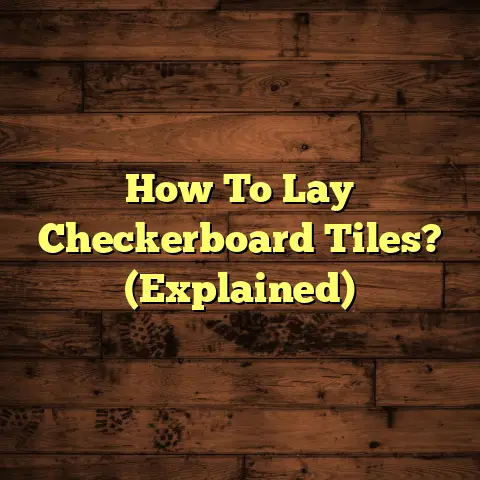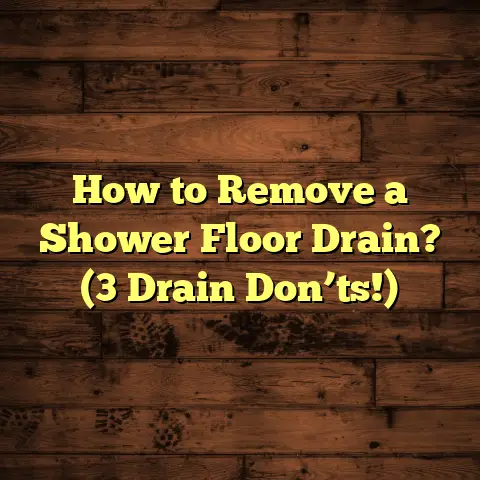Patching Concrete Floors: Pro Fixes! (5 Tips)
As a flooring contractor with years of experience, I’ve seen my fair share of cracked and damaged concrete floors.
And let me tell you, it’s not a pretty sight!
Especially here in the Midwest, where I’m based, we get hit with some seriously wild weather.
One day it’s scorching hot, the next it’s freezing.
All that expanding and contracting can really take a toll on your concrete.
But don’t worry, I’m here to help!
Ignoring those cracks can lead to bigger, more expensive problems down the road.
Think about safety hazards, like tripping, or even structural issues if the damage is severe enough.
That’s why I’m sharing my top 5 pro tips for patching concrete floors.
These are the same techniques I use on the job, and they’ll help you keep your floors looking great and lasting for years to come.
So, grab a cup of coffee, and let’s dive in!
Section 1: Understanding Concrete Floor Damage
Okay, so first things first, let’s talk about why concrete floors get damaged in the first place.
There are a few main culprits:
-
Environmental Factors:
- Like I mentioned before, extreme weather is a big one.
- Freeze-thaw cycles are particularly nasty.
- Water seeps into tiny cracks, then freezes and expands, making the cracks bigger.
- According to the Portland Cement Association, freeze-thaw damage is one of the leading causes of concrete deterioration in cold climates. PCA Website
-
Wear and Tear:
- This is pretty self-explanatory.
- Over time, foot traffic, heavy objects, and just general use can wear down the surface of your concrete.
- Think about your garage floor – all those cars driving over it day after day are bound to cause some wear and tear.
-
Improper Installation:
- This is a big one that a lot of people don’t think about.
- If your concrete wasn’t mixed or poured correctly to begin with, it’s going to be more prone to cracking and damage.
- Things like using the wrong water-to-cement ratio or not properly compacting the subgrade can all lead to problems down the road.
Now, let’s talk about the different types of damage you might see:
-
Cracks:
- These are the most common type of damage.
- They can range from hairline cracks that are barely visible to wide, deep cracks that are a serious concern.
- There are different types of cracks, too, like shrinkage cracks (which happen when the concrete dries), structural cracks (which are caused by movement in the foundation), and settlement cracks (which happen when the ground underneath the concrete settles).
-
Pitting:
- This is when small holes or depressions form on the surface of the concrete.
- It’s often caused by chemical exposure or freeze-thaw damage.
-
Scaling:
- This is when the surface of the concrete starts to flake or peel off.
- It’s usually caused by de-icing salts or other harsh chemicals.
-
Uneven Surfaces:
- This can happen when the concrete settles unevenly or when part of the surface gets damaged.
Here in the Midwest, we see a lot of damage from freeze-thaw cycles.
I’ve worked on countless garage floors and driveways where the concrete is riddled with cracks and pits because of the harsh winters.
I remember one job in particular where the client’s garage floor was so badly damaged that you could actually see the rebar underneath.
It was a mess!
Before you even think about patching your concrete, you need to figure out what kind of damage you’re dealing with and how bad it is.
This will help you choose the right repair materials and techniques.
Section 2: Tip #1 – Assessing the Damage
Alright, let’s get down to business.
My first tip is all about assessing the damage.
You can’t fix a problem if you don’t know what you’re dealing with, right?
Start by giving your concrete floor a good, hard look.
I mean, really get down there and examine it closely.
Here’s what you should be looking for:
-
Type of Damage:
- Is it a crack, a pit, scaling, or something else?
- Identifying the type of damage is the first step in figuring out how to fix it.
-
Severity of Damage:
- How big is the crack?
- How deep is the pit?
- Is the damage widespread, or is it just in one small area?
- For cracks, you’ll want to measure the width and depth.
- You can use a crack width gauge for this, which you can pick up at most hardware stores.
- For depth, you can use a small screwdriver or other pointed object to see how far it goes down.
-
Underlying Causes:
- This is where things get a little trickier.
- You need to try to figure out why the damage happened in the first place.
- Is it just normal wear and tear, or is there something else going on?
- Are there any signs of water damage, like staining or discoloration?
- Is the damage concentrated in one particular area, which might indicate a problem with the subgrade?
Once you’ve assessed the damage, it’s important to document your findings.
This will help you keep track of the problem and make sure you’re addressing it effectively.
Here’s what I recommend:
-
Take Photos:
- Before you start any repairs, take some photos of the damage.
- This will give you a visual record of the problem and help you track your progress.
- Make sure to take close-up shots as well as wider shots that show the surrounding area.
-
Make Notes:
- Write down everything you observe about the damage.
- What type of damage is it?
- How severe is it?
- What do you think caused it?
- Note any patterns or recurring issues.
- For example, are there cracks that always seem to reappear in the same spot?
-
Create a Diagram:
- If the damage is extensive, it can be helpful to create a diagram of your concrete floor and mark where the damage is located.
- This will give you a visual overview of the problem and help you plan your repairs.
I always tell my clients to think of themselves as detectives when they’re assessing concrete damage.
You’re trying to solve a mystery, and the more information you gather, the better your chances of finding the right solution.
Section 3: Tip #2 – Choosing the Right Repair Materials
Okay, so you’ve assessed the damage and you know what you’re dealing with.
Now it’s time to choose the right repair materials.
This is a crucial step, because using the wrong materials can actually make the problem worse.
There are a few main types of patching materials that I recommend:
-
Epoxy Fillers:
- Epoxy fillers are a great option for repairing cracks and chips in concrete.
- They’re very strong and durable, and they bond well to concrete.
- They’re also waterproof, which is important if you’re dealing with water damage.
- However, epoxy fillers can be a bit more expensive than other options, and they can be tricky to work with if you’re not experienced.
- They also don’t breathe, so they’re not a good choice for large areas or for concrete that’s prone to moisture.
- Pros: Strong, durable, waterproof.
- Cons: Expensive, tricky to work with, doesn’t breathe.
-
Polymer-Modified Cement:
- Polymer-modified cement is a mix of cement, sand, and polymers.
- The polymers add flexibility and strength to the cement, making it less likely to crack or chip.
- It’s a good option for repairing larger cracks and for resurfacing concrete floors.
- It’s also more breathable than epoxy, which is important if you’re dealing with moisture.
- However, polymer-modified cement isn’t as strong as epoxy, and it can be more prone to staining.
- Pros: Flexible, strong, breathable.
- Cons: Not as strong as epoxy, prone to staining.
-
Concrete Resurfacer:
- Concrete resurfacer is a thin layer of cement-based material that’s applied over the entire surface of the concrete floor.
- It’s a good option for repairing widespread damage, like scaling or pitting.
- It can also be used to give your concrete floor a new look.
- However, concrete resurfacer can be expensive, and it requires a lot of preparation work.
- It’s also not a good choice for repairing large cracks or uneven surfaces.
- Pros: Good for widespread damage, can give your floor a new look.
- Cons: Expensive, requires a lot of preparation, not good for large cracks or uneven surfaces.
When choosing a patching material, it’s important to consider the severity of the damage and the specific conditions of your environment.
For example, if you’re dealing with a small crack in your garage floor, an epoxy filler might be a good choice.
But if you’re dealing with widespread scaling on your patio, a concrete resurfacer might be a better option.
Here in the Midwest, we have a few local suppliers that I really like:
-
SpecChem:
- They have a great line of concrete repair products, and their customer service is top-notch. SpecChem Website
-
Euclid Chemical:
- They’re a national company, but they have a strong presence in the Midwest, and their products are very reliable. Euclid Chemical Website
No matter which material you choose, it’s important to make sure it’s compatible with your existing concrete.
Read the manufacturer’s instructions carefully and follow them to the letter.
I’ve seen too many people try to cut corners on this step, and it always ends up costing them more in the long run.
Section 4: Tip #3 – Preparing the Surface
Alright, you’ve got your patching materials.
Now, it’s time to prep the surface.
Trust me, this step is crucial.
If you skip it, your patch won’t adhere properly, and you’ll be back to square one in no time.
Here’s what you need to do:
-
Cleaning:
- Start by cleaning the affected area thoroughly.
- Remove any dirt, dust, grease, or loose debris.
- I recommend using a stiff-bristled brush and a concrete cleaner.
- For stubborn stains, you might need to use a pressure washer.
- Just be careful not to damage the surrounding concrete.
-
Grinding:
- Next, you’ll need to grind the surface of the concrete.
- This will create a rough surface that the patching material can grip onto.
- You can use a concrete grinder with a diamond grinding wheel for this.
- If you don’t have a concrete grinder, you can rent one from most tool rental stores.
- Just make sure to wear safety glasses and a dust mask when you’re grinding.
-
Drying:
- Once you’ve cleaned and ground the surface, it’s important to let it dry completely.
- This can take anywhere from a few hours to a few days, depending on the humidity and temperature.
- You can speed up the drying process by using a fan or dehumidifier.
- Make sure the surface is completely dry before you start applying the patching material.
Here’s a list of tools you’ll likely need:
- Broom
- Wire Brush
- Concrete Cleaner
- Pressure Washer (optional)
- Concrete Grinder
- Diamond Grinding Wheel
- Safety Glasses
- Dust Mask
- Fan or Dehumidifier (optional)
If you don’t have all of these tools, don’t worry.
As I mentioned, you can rent a concrete grinder from most tool rental stores.
Here are a few local options in the Midwest:
-
Sunbelt Rentals:
- They have a wide selection of tools and equipment, and their prices are very competitive. Sunbelt Rentals Website
-
United Rentals:
- They’re another great option for tool rentals, and they have locations all over the Midwest. United Rentals Website
I know that surface preparation can be a pain, but it’s really important to do it right.
Trust me, it’ll save you a lot of headaches in the long run.
Section 5: Tip #4 – Applying the Patch
Alright, the surface is prepped, and you’re ready to apply the patch.
This is where the magic happens!
But before you start slathering on the patching material, there are a few things you need to know.
First, always follow the manufacturer’s instructions.
I know it sounds obvious, but you’d be surprised how many people skip this step.
The manufacturer knows their product best, so trust them and follow their instructions to the letter.
Next, make sure you have the right tools for the job.
You’ll need a mixing bucket, a trowel, and a sponge.
For mixing, I highly recommend using a drill with a mixing paddle.
It’ll save you a lot of time and effort.
Now, let’s get to the actual application process:
-
Mixing:
- Mix the patching material according to the manufacturer’s instructions.
- Be sure to add the right amount of water.
- Too much water will weaken the patch, and too little water will make it difficult to work with.
- Mix the material thoroughly until it’s smooth and creamy.
-
Applying:
- Apply the patching material to the damaged area with a trowel.
- Press it firmly into the crack or pit to ensure good adhesion.
- Overfill the area slightly, as the material will shrink as it dries.
-
Finishing:
- Once the patching material has been applied, use a trowel to smooth it out and feather the edges.
- This will help it blend in seamlessly with the surrounding concrete.
- For a smooth finish, you can use a damp sponge to lightly wipe the surface.
-
Curing:
- Finally, you need to let the patching material cure properly.
- This can take anywhere from 24 hours to several days, depending on the material and the weather conditions.
- Keep the area moist during the curing process by covering it with plastic or spraying it with water.
Here in the Midwest, we have to be especially careful about curing times.
In the summer, the hot, dry weather can cause the patching material to dry out too quickly, which can lead to cracking.
In the winter, the cold weather can slow down the curing process, which can weaken the patch.
To combat these problems, I recommend using a curing compound.
A curing compound is a liquid that you spray on the patching material to help it retain moisture and cure properly.
You can find curing compounds at most hardware stores.
Section 6: Tip #5 – Preventing Future Damage
You’ve patched your concrete floor, and it looks great!
But don’t get too comfortable just yet.
The best way to keep your concrete floor looking good is to prevent future damage.
Here are a few tips:
-
Regular Maintenance:
- Sweep or vacuum your concrete floor regularly to remove dirt and debris.
- This will prevent the buildup of abrasive particles that can scratch the surface.
- Mop your concrete floor with a mild detergent and water to remove stains and spills.
- Avoid using harsh chemicals or abrasive cleaners, as they can damage the surface.
-
Seasonal Inspections:
- Inspect your concrete floor regularly for signs of damage, such as cracks, pits, or scaling.
- Pay special attention to areas that are exposed to the elements, such as patios and driveways.
- Catching problems early can prevent them from becoming bigger and more expensive to repair.
-
Sealants and Coatings:
- Apply a sealant or coating to your concrete floor to protect it from moisture and wear.
- There are many different types of sealants and coatings available, so choose one that’s appropriate for your needs.
- For example, if you live in an area with harsh winters, you might want to choose a sealant that’s resistant to de-icing salts.
Here are some climate-specific tips:
-
Winter:
- Use de-icing agents sparingly, as they can damage concrete.
- Choose a de-icing agent that’s specifically designed for concrete.
- Avoid using metal shovels or ice picks to remove ice from your concrete floor, as they can scratch the surface.
-
Summer:
- Control humidity in your garage or basement to prevent moisture damage.
- Use a dehumidifier to keep the humidity level below 50%.
- Avoid parking cars with hot tires on your concrete floor, as the heat can cause the concrete to expand and crack.
I always tell my clients that preventing damage is much easier and cheaper than repairing it.
By taking a few simple steps, you can keep your concrete floor looking great for years to come.
Conclusion
So, there you have it! My top 5 pro tips for patching concrete floors.
I know it can seem like a daunting task, but with the right knowledge and tools, anyone can do it.
Remember, addressing concrete floor damage promptly and effectively is crucial for maintaining the safety, value, and longevity of your property.
Here’s a quick recap of the tips we covered:
-
Assess the Damage:
- Identify the type and severity of the damage, and try to determine the underlying causes.
-
Choose the Right Repair Materials:
- Select a patching material that’s appropriate for the type and severity of the damage, and make sure it’s compatible with your existing concrete.
-
Prepare the Surface:
- Clean, grind, and dry the affected area to ensure optimal adhesion of the patching material.
-
Apply the Patch:
- Mix, apply, and finish the patching material according to the manufacturer’s instructions.
-
Prevent Future Damage:
- Implement regular maintenance practices, seasonal inspections, and protective measures to minimize future damage.
I hope you found this article helpful.
Now, I’d love to hear from you!
Have you ever patched a concrete floor before?
What was your experience like?
Do you have any tips or tricks to share?
Let me know in the comments below!
And if you have any questions, feel free to ask.
I’m always happy to help.
Thanks for reading, and happy patching!





